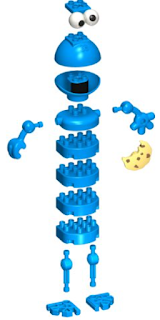 |
Cookie Monster 15 piece construction set. |
 The cookie monster, a favorite Sesame Street character, is the star of this K'Nex construction set. Fifteen heavy-duty, smooth, brightly-colored plastic pieces and a guide for building five models come stored in a plastic blue container (see image above). The lid fits on the top, but does not snap on securely. Some of the K'Nex
pieces are jointed, as you can see (left) at the elbows and
knees, allowing for more dynamic play once the building is complete.
The cookie monster, a favorite Sesame Street character, is the star of this K'Nex construction set. Fifteen heavy-duty, smooth, brightly-colored plastic pieces and a guide for building five models come stored in a plastic blue container (see image above). The lid fits on the top, but does not snap on securely. Some of the K'Nex
pieces are jointed, as you can see (left) at the elbows and
knees, allowing for more dynamic play once the building is complete.K'Nex is one of my favorite brands and they have many different sets, some based on well-known characters, but many with more common themes such as animals and vehicles. Most sets are a mix of generic models and have more pieces than this set.
Four of the models in this building guide, as in many of their guides, are shown already assembled. This is a more difficult build than if you are shown a piece or two at a time, such as with LEGO building guides. The individual will have to be able to look at a finished model and assess where to start building and how to proceed. Models range from five pieces to all 15 pieces. Below is a picture of the guide and a couple pieces.
Try this:
Try this:
- Play with the pieces before constructing so the individual can see how they fit together.
- Use a white piece of paper to cover pieces (on the building guide) that you have not gotten to yet to reduce confusion and direct the building sequence.
- Encourage the use of two hands in building whenever possible.
- Set a piece at a time in front of the individual to cue him which piece to add next.
- Place pieces in a pile on the table before construction. Turn pieces upside-down, sideways, etc., burying parts of some, so that the individual will have to recognize the correct pieces in different orientations.
- Enjoy a real cookie with the cookie monster as you admire your handiwork.
- Work on visual discrimination, visual closure, visual form constancy, figure ground, eye-hand coordination, manual dexterity, coordinated use of both hands, in-hand manipulation, finger/hand strength, motor planning, executive function, sequencing, process skills, play and leisure exploration and participationIn the container: 15 pieces, building guide





